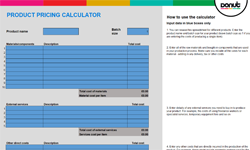
Art shops supply the essentials used by amateur and professional artists and art students. Get the essentials for starting up and running your own art shop in our practical guide.
- Research your target market
- Decide what services to offer
- What to sell
- Selling on ebay and Amazon
- Pricing policy
- Promote your business
- Buy an existing business
Research the target market for your art shop
When you plan your art shop business it's important to make an estimate of how much demand there will be and to think about what customers will want. Doing some market research will help you with this.
Estimating demand for your art shop
You'll want to make sure that there's enough demand for an art shop in your area. Artists' materials and related craft and hobby items are stocked by a number of different suppliers, such as WH Smith, Hobbycraft, discount book retailer The Works, mixed retail chain The Range, and often local knitting, sewing and craft shops. Many professional-quality paints, brushes and other materials are available to order from specialist catalogues and more and more art shops and suppliers sell online. Some retailers, such as GreatArt, specialise in selling online, while there are plenty of traders selling artists' supplies on eBay and Amazon Marketplace. And when all's said and done, the market for artists' materials is fairly limited - plenty of people never buy them.
So you will need to find out not only how many direct competitors you will have but also how big your local market will be. Ideally, you will be locating in a sizeable town or city which has a thriving art college, so that you can target the student population. Many adult education courses in painting, drawing, sculpture, ceramics, stained glass and so on are offered by local colleges and these will also generate demand for your business. Maybe your area has become renowned for attracting artists from all over the country (such as St Ives in Cornwall and Southwold in Suffolk) and has a thriving community of artists who will all need regular supplies of materials.
As a first step, check out the competition in your area to identify how many other outlets are already selling artists' materials locally. Try to establish:
- what ranges they sell and what prices they charge
- what their opening hours are
- which services they offer, if any
- how knowledgeable and helpful their staff are
- whether they are prepared to order items that they don't normally stock
Your market
It's likely that your customers will include members of the public and also local businesses and organisations.
Members of the public might include:
- amateur artists
- students (both full and part-time)
- members of local art groups
- people buying gift sets, general stationery items and so on, depending on what you decide to sell
Your trade customers might include:
- professional artists
- graphic design studios
- schools, colleges and nurseries
- businesses such as picture restorers
You might decide to offer account facilities to certain trade customers and perhaps to others who buy products from you in large volumes.
Why will customers choose your art shop
You'll want to make sure that enough customers will choose your shop - rather than existing outlets. Your market research might indicate that there is a gap in the market that your shop can fill. For example, perhaps no one in your area specialises in professional quality paints and other artists' materials despite the fact that your area hosts many artists' workshops.
One of the independent's great strengths is in-depth knowledge of the artists' materials they sell so that they can offer personal service and helpful advice to their customers. This is a service that major national stores such as WH Smith have difficulty in providing, so you should make sure your customers are aware of what you can offer.
Find out what people want
Small independent retailers face tough competition from large chain stores and other outlets. So it is very important that you find out what people want and whether there are particular goods or services you can offer which will attract customers to your shop. If you plan to carry out a local survey, don't forget that your customers might include trade customers such as art colleges, schools, nurseries and graphic design studios, all of which regularly require art and craft materials.
Research current trends, plus legal and tax issues
Decide what services your art shop will offer
As well as stocking a wide range of artists' materials, sundries and accessories you will probably also offer various services. Depending on your equipment, skills and experience you might decide to offer:
- canvas stretching
- picture framing
- picture cleaning and restoration
- painting and drawing lessons
Even if you don't have the skills and experience to carry these out yourself, you may decide to outsource them to a specialist so that you can offer a range of services that can help to attract people to your shop.
Offering to order specific items for customers if you don't stock them will help to build up a loyal customer base.
If you have trade customers such as local schools, colleges or nurseries you might decide to offer a delivery service to them. Think about whether you will offer a mail order and/or e-commerce service.
If you plan to sell work by local artists you might consider doing this on a commission basis - so that you just keep a percentage of the sale price rather than actually buying the paintings and other works from the artists.
What to sell in your art shop
The range of artists' materials and other products that you decide to sell will depend on the focus of your outlet. You may decide that your core customer base will be made up of a mix of professional artists, art students and amateur artists - if so you will probably stock a range of artists' materials in various different qualities and price ranges.
You might decide that specialist artists' materials will only be part of your range and that you will also stock a variety of more general items such as stationery, posters and prints. The amount of space you will have, as well as your prospective customer base, will influence your choice of stock. However, you may sell some or all of the following:
- paints - oil, watercolour, gouache and acrylic. These may be sold in sets as well as individually
- brushes
- pencils, pastels, crayons, charcoal, pens, inks
- artists' sundries such as palettes, palette knives, thinners, fixers, adhesives, varnish and so on
- paper and card, both in pads and single sheets
- canvasses
- craft and hobby tools and items for a wide range of activities such as sculpting, ceramics, papier mache, candle making, needlecraft, lace making, mosaics, stained glass, textile painting and so on
- decorative finishes, such as gold leaf for gilding
- graphic design materials, airbrushes and compressors
- easels, portfolios
- work by original artists, prints and posters
- frames
- books and DVDs
- gift sets
- general stationery items
Many of your suppliers can provide you with point-of-sale leaflets and display stands, but they may make a charge for these.
Selling art supplies on ebay and Amazon
Selling online can be an excellent way of reaching new customers and boosting your sales. But setting up your own ecommerce website can be expensive and you may not be sure at the beginning whether the value of the sales you'll make online will justify the set-up costs.
As an alternative, trading on eBay or Amazon lets you get a feel for selling online but with much lower start up costs. And you may decide to keep on selling through eBay and Amazon even when you have your own online shop.
Getting started
You might already have your own personal eBay account that you use to buy items for yourself and to sell things that you don't need any more. But if you're trading as a business on eBay you're legally obliged to make it clear in your listings that you're a business seller. This means that you'll either need to register a new business account or upgrade your personal account to a business one. There's guidance in the eBay Seller Centre on the definition of 'trading' if you're not sure whether you need to register as a business seller.
Similarly, with Amazon, you can use an existing account or create a new one when you register as a business seller.
If you're not already running a business and you intend to start selling things on eBay or Amazon - perhaps just in a small way to begin with - then you'll need to notify HM Revenue & Customs (HMRC) that you're trading. There's guidance on the Gov.uk website that gives an overview of what counts as trading and what counts as self employment. It also gives details of your tax and record keeping obligations.
Decide whether to have your own virtual 'shop'
Having your own virtual storefront will give your business a valuable online presence and will allow you to display all your products together in one place.
When you sign up to sell on eBay, you have the option of setting up an eBay Shop. This allows you to create your shop using an existing template or to customise it to your own design. You don't have to choose the eBay Shop option straight away - you may decide it's best to wait until your monthly sales build up to a certain level and then upgrade.
With Amazon, you'll automatically create your own storefront regardless of the package you choose. You won't be able to customise it very much but you will be able to add your name and logo and provide some information about your business.
How much does selling on Amazon and eBay cost?
Before you start selling on Amazon and eBay it's a good idea to find out how much you'll have to pay in fees. Depending on the items you sell and the method you choose for selling them, your total fees can be quite substantial. And while some of the fees you pay will be linked to the number of items you sell each month, others are likely to be fixed costs which you incur even if you don't sell anything.
Both eBay and Amazon give you the option of selling as a business seller without paying any fixed monthly fees, although it's usually more cost-effective to choose a subscription-based package unless you're only selling a small number of items each month.
The eBay website has a fee illustrator tool and a fee calculator that will help you compare the fees for different selling methods and get a good idea of how much your actual per-item selling fees are likely to be.
The Amazon website gives detailed fee guidance, including some examples of pricing for their subscription and non-subscription packages.
Managing your listings
Uploading your inventory to eBay or Amazon and managing your listings can be a time consuming task, particularly if you're planning to sell a large number of items.
Both eBay and Amazon offer useful listing tools, some of which are free and others that you'll have to pay for.
Promoting your art supplies
Because there's such a huge number of items for sale on eBay and Amazon at any one time, it's very important that you do everything you can to stand out from the crowd.
Always make sure that your listings include accurate, spell-checked descriptions and that your photos and other images show the items that you're selling in the best possible light.
You might want to take it a step further and use the various marketing tools provided by eBay and Amazon such as search optimisation, cross-promotions and paid-for advertisements.
Your reputation
As an eBay or Amazon seller your online reputation is extremely important. All sellers have a feedback score based on actual customer feedback and this is the main measure that future customers will use to check that you are trustworthy and reliable.
So you'll want to keep your rating as high as possible by providing an excellent level of customer service and fast delivery at reasonable prices. Make sure you always respond promptly to customer queries, deal with returns efficiently and keep an eye on your stock levels to avoid your listings showing an item as being in stock when it has sold out.
Be aware that packing up orders and sending them out can be time consuming, but it's important to stay on top of the job to make sure that the right items get delivered in good time to the right people. Very many parcel delivery services now offer bulk shipping tools that integrate with your eBay or Amazon account and these can greatly simplify the process of arranging and tracking your deliveries.
If you're selling on Amazon you might also consider using the Fulfilment by Amazon service, where you send Amazon your inventory and they do all of the picking, packing and shipping as well as providing customer service.
More information
The eBay and Amazon websites have a great deal of useful guidance to help you get started as a business seller and to expand your business as demand for your products grows. Both also have lively seller community forums where experienced sellers are often happy to answer questions.
Pricing policy
Getting the price right is very important. You must make sure that the difference between the cost price and the selling price is enough to cover all of your operating costs, including your own drawings. However, be aware that artists can buy materials from a number of different sources, including online, and you will have to price in line with your immediate competitors unless you are targeting a niche market that your competitors do not cater for.
If you're going to sell from a shop and online think about whether you will have a two-tier pricing policy or use the same prices both in your shop and on the website. If you need to sell at lower prices online - perhaps to compete with other online retailers' prices - then think about what you will do if people come into your shop and ask to buy something at your web price.
Regular customers will appreciate the knowledgeable service that you can provide and the wide range of professional and amateur quality artists' materials that you are likely to stock. However, you don't want them coming to your shop to pick your brains and then going elsewhere to buy what they want because you have pitched your prices too high. On the other hand, you don't want to set your prices too low because you may not make enough profit to keep going.
Your suppliers may include suggested retail prices in their catalogues and price lists. It is entirely up to you whether or not you stick to the suggested retail price, but if you do decide to price your stock below the suggested retail prices you should keep details of your actual selling prices.
 Free pricing calculator
Free pricing calculator
Setting the right price right is essential. Too high, and you'll struggle to make the sale. Too low and you're throwing away potential profit.
Make sure the price is right with our free product pricing calculator. Answer a few quick questions to work out what you should be charging.
Special offers and discounts
You may well offer a discount to certain customers. For example, many artists' materials shops offer students a discount - often as much as 20% off the normal retail price. Any trade customers that you have will also expect a discount from the normal retail price, especially if they are buying in large quantities on a regular basis. The amount of discount you offer will probably depend on your pricing policy and how much local competition there is. You might also offer a small discount to members of a local art group.
You might decide to offer a price-match promise to reassure your customers that they're always getting good value when they shop with you.
Keep a close eye on any special offers you do make to be sure that they're working for you. After all, these kinds of promotion might encourage extra sales, but they'll also affect the amount of profit you make on each sale.
Promote your art shop
The right image
It's important that your shop projects the right image to customers. Everything about the way your shop looks and feels should be designed to encourage existing customers to keep coming back regularly.
It's a very good idea to make the outside of the shop as attractive and welcoming as possible. Try to make sure that signs are professionally made, clean and in good condition. Use colours, lettering and design that you feel put across the right image. Bear in mind that things like the condition of the paintwork can make a difference between a shop that looks like it's up and coming and one that looks old and run-down. Keep your windows spotlessly clean and well lit.
Make sure that your window displays are attractively laid out and changed regularly. You could display a piece of work by a local artist surrounded by the range of artists' materials that would be required to produce a similar piece of artwork. If you offer other services like picture framing or painting lessons, then it's a good idea to advertise these in your window or on a sign outside your shop.
You are likely to stock hundreds of different items, so try to make sure they're arranged neatly to help customers find what they are looking for and to ensure that goods such as loose sheets of paper and sketch pads don't get damaged. Look into ways of encouraging customers to buy as much as possible. For example, you could put a rack of inexpensive general stationery items on the countertop next to the till. Talk to your suppliers about the availability of attractive point-of-sale materials such as stands, leaflets and signs.
It goes without saying that you and any staff you employ play a key role in the image of your business. Customers will expect staff to be friendly, helpful and enthusiastic. Ideally, they will also have an in-depth knowledge of the artists' materials you sell and be able to give customers helpful advice. This is a service that major national chains such as WH Smith find it difficult to offer.
Advertising and marketing your art shop
You'll want to make sure that as many potential customers as possible know about the products and services you offer.
There are a number of things you can do to promote your business, for example:
- launch your own website, showing all the features that will attract customers to your outlet. You could also sell goods through your website if it's e-commerce enabled
- use social media, forums and blogs to stay in regular touch with existing customers and to make contact with potential new customers
- run a regular email newsletter for customers who agree to receive it, telling them about the latest new products and special offers
- offer professional artists a loyalty discount scheme
- offer local students a discount - try to make sure that your local art college has plenty of promotional leaflets advertising your outlet
- contact local art groups and tell them about your stock - perhaps you could give a talk or demonstration
- leave your contact details at any local galleries
- advertise in specialist media like Artists & Illustrators magazine
- run a painting competition with products for prizes
- advertise in your local newspaper and any local directories
- offer special discounts and free goods from time to time - for example buy one get on free on certain products. Advertise special offers prominently in your window
- use 'daily deal' websites like Groupon and Wowcher to promote special offers
Almost all types of advertising and promotion have a cost, whether it's financial or your own time and effort - or both. You need to make sure that the beneficial effects of your advertising efforts are worth the time and money spent on them. It's up to you to decide which types of advertising work best for you - sometimes this is down to trial and error.
Buy an existing art shop
You might decide to buy an existing art shop rather than start your own venture from scratch. Buying a going concern can mean that the products, customers, regular sales, staff, premises and equipment are already in place.
But buying a business can be a hazardous, expensive process unless you have the right skills and experience on your team, including legal and financial know-how. Establish a genuine trading and financial position, so that the price you pay for the business is not too high.



